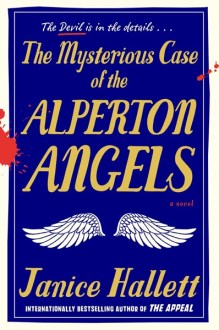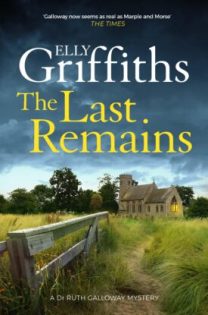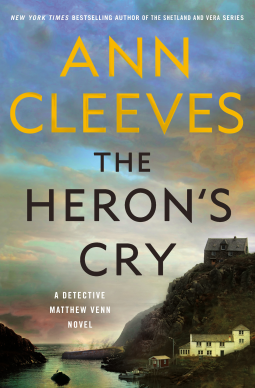 The first time I tried to read Hallet’s Mysterious Case of the Alperton Angels, I failed, her writerly choices leaving me nonplussed. But I then listened to the NYT’s books podcast praising it to high heaven. The reviewer said she bought FOUR copies and lent them to make sure people were reading Alperton Angels! Most read till the wee hours…’fession, I did too.
The first time I tried to read Hallet’s Mysterious Case of the Alperton Angels, I failed, her writerly choices leaving me nonplussed. But I then listened to the NYT’s books podcast praising it to high heaven. The reviewer said she bought FOUR copies and lent them to make sure people were reading Alperton Angels! Most read till the wee hours…’fession, I did too.
Why? Because Hallett’s is no ordinary straight-telling mystery: the how she tells the story is as compelling, though disorienting, as the mystery. Readers of Hallett’s previous two books (now in the Gargantuan TBR) may be old hands at her unique narrative choices, but I was taken in, fascinated, and ready to do it again.
Centred on true crime writer Amanda Bailey as she gathers material to complete her book on the Alperton Angels, the narrative is made up of snail and e-mail, text and Whatsapp messages, interview and podcast transcripts, quasi-fictional accounts, old documentaries, an unproduced movie script, even a YA fantasy novel. Characters are as diverse: police, witnesses, family members, podsters, authors, nurses, even amateur true crime club members. The effect is compelling, disorienting, fragmentary. As Amanda puts the pieces together, so does the reader (I’m vain enough to say I guessed one part of the mystery correctly… but there were surprises too. Clever Hallett: we aren’t privy to motivation.) (more…)

 When I saw Cleeves’s third “Two Rivers” mystery would soon be out, I realized I hadn’t read the second. Hence, an “ARC” review from 2021…oopsy. As with the first, I greatly enjoyed this, with minor quibbles. As for number two standing alone, it does so quite fine as far as the mystery is concerned. But what makes Cleeves’s series great is the characterization of a wonderful ensemble cast. Read number one, get to know them, enjoy them, and continue doing so with The Heron’s Cry …while I eagerly get into number three, The Raging Storm (stay tuned!). For now, let’s have the publisher’s blurb set us up with The Heron Cry‘s details:
When I saw Cleeves’s third “Two Rivers” mystery would soon be out, I realized I hadn’t read the second. Hence, an “ARC” review from 2021…oopsy. As with the first, I greatly enjoyed this, with minor quibbles. As for number two standing alone, it does so quite fine as far as the mystery is concerned. But what makes Cleeves’s series great is the characterization of a wonderful ensemble cast. Read number one, get to know them, enjoy them, and continue doing so with The Heron’s Cry …while I eagerly get into number three, The Raging Storm (stay tuned!). For now, let’s have the publisher’s blurb set us up with The Heron Cry‘s details: Other than The Singing Detective, one of the best television series I’ve seen is Blackpool, a musical murder mystery set in, you guessed it, Blackpool! Davids Morrisey and Tennant sing! There’s a seedy arcade, a dead body, illicit love affairs, and kitsch galore, it doesn’t get better than this. Or weirder. I didn’t think anything could top it until I read Billingham’s Blackpool-set The Last Dance. Like Blackpool, it’s an original, thanks to Billingham’s Detective Declan Miller. Miller is morbid, funny, buffoon-ish, but also epitomizes dogged, persistent, plugging-away-at-it police work. Miller’s voice and The Last Dance‘s premise are distinctive. The publisher’s blurb offers the gist of plot and character:
Other than The Singing Detective, one of the best television series I’ve seen is Blackpool, a musical murder mystery set in, you guessed it, Blackpool! Davids Morrisey and Tennant sing! There’s a seedy arcade, a dead body, illicit love affairs, and kitsch galore, it doesn’t get better than this. Or weirder. I didn’t think anything could top it until I read Billingham’s Blackpool-set The Last Dance. Like Blackpool, it’s an original, thanks to Billingham’s Detective Declan Miller. Miller is morbid, funny, buffoon-ish, but also epitomizes dogged, persistent, plugging-away-at-it police work. Miller’s voice and The Last Dance‘s premise are distinctive. The publisher’s blurb offers the gist of plot and character: “Murder and mayhem,” many reviewers note about Cosimano’s Finlay Donovan series… And I certainly got gobs of it listening to book #3. There are readers who love a plot-driven narrative and readers who don’t and what I again learned was I’m not the lover of the plot-driven narrative…BUT I absolutely loved this narrator and would listen to her read a grocery list. More of why later. For now, here’s the convoluted Finlay Donovan plot from the, thank the reading gods, publisher, because I certainly couldn’t unravel it:
“Murder and mayhem,” many reviewers note about Cosimano’s Finlay Donovan series… And I certainly got gobs of it listening to book #3. There are readers who love a plot-driven narrative and readers who don’t and what I again learned was I’m not the lover of the plot-driven narrative…BUT I absolutely loved this narrator and would listen to her read a grocery list. More of why later. For now, here’s the convoluted Finlay Donovan plot from the, thank the reading gods, publisher, because I certainly couldn’t unravel it: My sole regret in listening to Exiles‘ twelve hours is that I neglected to read The Dry and Force Of Nature, both still nestled in my TBR. Gah, this was good, though I couldn’t for the life of me figure out why for the first oh ten or so hours. As I listened to the final two, it hit me: I had experienced one of the most elaborate, meandering premises I’d ever read, taken in, bamboozled, yet the whole time I was smugly making assumptions about who, what, where, and why. Having come to the end, I have to decide: did I just read something I can throw the “contrived” criticism at, or something utterly clever, brilliant, and compelling? For starters, let’s offer the publisher’s blurb to get some narrative details out of the way:
My sole regret in listening to Exiles‘ twelve hours is that I neglected to read The Dry and Force Of Nature, both still nestled in my TBR. Gah, this was good, though I couldn’t for the life of me figure out why for the first oh ten or so hours. As I listened to the final two, it hit me: I had experienced one of the most elaborate, meandering premises I’d ever read, taken in, bamboozled, yet the whole time I was smugly making assumptions about who, what, where, and why. Having come to the end, I have to decide: did I just read something I can throw the “contrived” criticism at, or something utterly clever, brilliant, and compelling? For starters, let’s offer the publisher’s blurb to get some narrative details out of the way:  I’m a Deanna-Raybourn fan-girl and would read her napkin doodles, but I wasn’t sure about Killers of a Certain Age. I do love me older-women-kick-ass heroines and in this case, there are four, but I’ve never been able to stomach making heroes out of assassins, or heroines for that matter; as the narrator quips, “It was the Wild West with no law but natural justice”. Um, no, vigilante justice is problematic whether men or women exact it. In the end, Killers of a Certain Age entertained me, but wasn’t powerful enough to dispel my niggling ugh-assassins conscience. But a premise is a premise is a premise and it’s Raybourn’s, so I can’t fault her for it. If this were to be a series, I’d not follow Raybourn to the next book, but it looks, at least to me, it’s a standalone (I’d still argue the ending had a whiff of sequel-bait to it, though). But onwards to the merits and demerits of Killers. First, a bit of a synopsis courtesy of the publisher’s back-cover copy:
I’m a Deanna-Raybourn fan-girl and would read her napkin doodles, but I wasn’t sure about Killers of a Certain Age. I do love me older-women-kick-ass heroines and in this case, there are four, but I’ve never been able to stomach making heroes out of assassins, or heroines for that matter; as the narrator quips, “It was the Wild West with no law but natural justice”. Um, no, vigilante justice is problematic whether men or women exact it. In the end, Killers of a Certain Age entertained me, but wasn’t powerful enough to dispel my niggling ugh-assassins conscience. But a premise is a premise is a premise and it’s Raybourn’s, so I can’t fault her for it. If this were to be a series, I’d not follow Raybourn to the next book, but it looks, at least to me, it’s a standalone (I’d still argue the ending had a whiff of sequel-bait to it, though). But onwards to the merits and demerits of Killers. First, a bit of a synopsis courtesy of the publisher’s back-cover copy:  Three sleepless nights and I finally turned the last page of Tana French’s In the Woods. It was my first, and will not be my last French, because it surprised me. When you’ve been reading as long as I have, well, not much does. Which can be comforting (romance serves this purpose well), or boring as heck. I was in thrall to French’s writing (rare in mystery, rarer in romance), which was horrific, funny, and penetrating all at once, at her broken, flawed, knowable and unknowable detectives, and her daring in solving one crime and leaving another hanging. (Note: I took the accompanying picture of the morning sky on Dec. 16, 2021.)
Three sleepless nights and I finally turned the last page of Tana French’s In the Woods. It was my first, and will not be my last French, because it surprised me. When you’ve been reading as long as I have, well, not much does. Which can be comforting (romance serves this purpose well), or boring as heck. I was in thrall to French’s writing (rare in mystery, rarer in romance), which was horrific, funny, and penetrating all at once, at her broken, flawed, knowable and unknowable detectives, and her daring in solving one crime and leaving another hanging. (Note: I took the accompanying picture of the morning sky on Dec. 16, 2021.) Elly Griffiths’s second Harbinder Kaur mystery tells us more about her love of Golden Age mystery writers, Murder She Wrote, and Georgette Heyer than it stands as exemplary crime fiction. I did not give an owl’s hoot about this, but to the tightly-plotted-is-best mystery reader, Postscript Murders is a sprawling mess, an octopus of great characters going nowhere in a plot meandering towards the improbable. Still, I liked it. I’m a fan of character-driven mystery, especially when the characters, amateur and professional, work together to solve the crime.
Elly Griffiths’s second Harbinder Kaur mystery tells us more about her love of Golden Age mystery writers, Murder She Wrote, and Georgette Heyer than it stands as exemplary crime fiction. I did not give an owl’s hoot about this, but to the tightly-plotted-is-best mystery reader, Postscript Murders is a sprawling mess, an octopus of great characters going nowhere in a plot meandering towards the improbable. Still, I liked it. I’m a fan of character-driven mystery, especially when the characters, amateur and professional, work together to solve the crime.  I avoided coming to the point where I must wait for the next Ruth Galloway (next June, folks), but here I am after tapping the last Kindle page of
I avoided coming to the point where I must wait for the next Ruth Galloway (next June, folks), but here I am after tapping the last Kindle page of